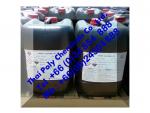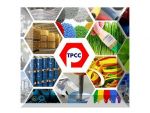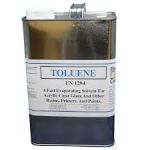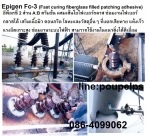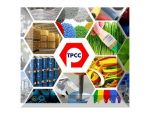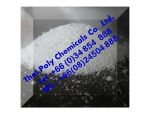ฟอร์มาลีน, ฟอร์มัลดีไฮด์, Formalin, Formaldehyde |
฿1 |
|
ชื่อผู้ประกาศ : ไทยโพลีเคมิคอล เบอร์โทรศัพท์ : 034854888, 034496284 โทรศัพท์มือถือ : 0800160016 ที่อยู่ : 36/5 ม.9 ต.นาดี อ.เมืองสมุทรสาคร จ.สมุทรสาคร 74000 ร้าน Thai Poly Chemicals |
ฟอร์มาลิน,
ฟอร์มัลดีไฮน์, Formalin,
Formaldehyde
ทางเคมี (Chemical Name): ฟอร์มาลดีไฮด์ (Formaldehyde)
ชื่อพ้อง(Synonyms):
Formaldehyde; Formalin; Methanal; Formic aldehyde; Methaldehyde
ชื่อIUPAC(IUPAC
Name): Formaldehyde
สูตรเคมี(Chemical
Formula): CH2O
ฟอร์มาลิน (Formalin) หรือสารละลายฟอร์มาลดีไฮด์
(Formaldehyde) มีสูตรเคมีว่า CH2O คนทั่วไปรู้จักกันว่าเป็นสารที่ใช้สำหรับดองศพเพื่อไม่ให้ศพเน่าเปื่อย
ใช้ฆ่าเชื้อโรค ฆ่าเชื้อรา และทำความสะอาดห้องคนป่วย ลักษณะทั่วไปของฟอร์มาลินเป็นสารละลายใส ไม่มีสี มีกลิ่นฉุนเฉพาะตัว เป็นสารรีดิวซ์รุนแรง เมื่อสัมผัสกับอากาศจะถูกออกซิไดส์ช้า ๆ ใช้ฆ่าเชื้อโรคในเครื่องมือต่าง ๆ เช่น เครื่องฟอกเลือด (เครื่องล้างไต) เครื่องมือเครื่องใช้ในการเตรียมและสังเคราะห์ผลิตภัณฑ์ยา วัคซีน ไอระเหยของฟอร์มาดีไฮด์สามารถนำมาอบห้องฆ่าเชื้อโรคตามโรงพยาบาล ในการทำเครื่องสำอางจะใช้สารฟอร์มาลินในยาสีฟัน ยาบ้วนปาก สบู่ ครีมโกนหนวดเพื่อฆ่าเชื้อโรค โดยใช้เป็นส่วนประกอบในความเข้มข้นที่ต่ำมาก ใช้ในน้ำยาดับกลิ่นตัว ใช้เป็นส่วนประกอบของแชมพูสำหรับสัตว์เลี้ยง เป็นต้น ในด้านอุตสาหกรรม ฟอร์มาลินมีสมบัติทำให้ผ้าและกระดาษแข็งเกาะกัน จึงนำมาใช้ในการทำบอร์ดหรือไม้อัด รักษาผ้าไม่ให้ยับหรือย่น ในอุตสาหกรรมกระดาษ ใช้เพื่อให้กระดาษลื่นและกันน้ำได้ เป็นต้น ส่วนในด้านการเกษตรใช้สารฟอร์มาลินทำลายและป้องกันจุลินทรีย์ที่ทำให้ต้นไม้เป็นโรค ใช้เก็บรักษาและป้องกันผลิตผลเกษตรจากการเสียหายระหว่างการขนส่ง ใช้ฆ่าเชื้อราในดิน ใช้เป็นส่วนผสมของสารละลายที่ใช้เคลือบผัก ผลไม้จำพวกส้มระหว่างการเก็บเกี่ยวเพื่อชะลอการเน่าเสีย เป็นต้น พ่อค้า แม่ค้า นิยมนำฟอร์มาลินมาแช่ผัก เนื้อสัตว์ และอาหารทะเลสด เพื่อทำให้อาหารต่างๆ สดอยู่ได้นานไม่เน่าเสียเร็ว
ฟอร์มาลิน หรือ สารละลายฟอร์มาลดีไฮด์
หมายถึงสารละลายที่ประกอบด้วยแก๊ส ฟอร์มาลดีไฮด์ประมาณร้อยละ 37-40(ในน้ำ) มีเมทานอลปนอยู่ประมาณร้อยละ 10-15 เพื่อป้องกันไม่ให้ฟอร์มาลินเปลี่ยนรูปไปเป็นโพลิเมอร์พาราฟอร์มาดีไฮด์ซึ่งเป็นพิษมากกว่าฟอร์มาลินมาก ฟอร์มาลินเป็นสารที่ใช้สำหรับดองศพเพื่อไม่ให้ศพเน่าเปื่อย
ใช้ฆ่าเชื้อโรค ฆ่าเชื้อรา และทำความสะอาดห้องคนป่วย ดังนั้นพ่อค้า
แม่ค้าจึงนิยมนำฟอร์มาลินมาแช่ผัก เนื้อสัตว์ และอาหารทะเลสด ทำให้อาหารต่างๆ
สดอยู่ได้นาน โดยไม่เน่าเสียเร็ว แต่ก่อให้เกิดอันตรายต่อผู้บริโภคได้
ดังนั้นฟอร์มาลินหรือสารละลายฟอร์มาลดีไฮด์
เป็นวัตถุห้ามใช้ในอาหารตามประกาศของกระทรวงสาธารณสุข หากใครใส่สารนี้ในอาหาร
จะต้องระวางโทษจำคุกไม่เกิน 2 ปี หรือปรับไม่เกิน 20,000 บาท หรือทั้งจำทั้งปรับ ลักษณะทั่วไปของฟอร์มาลินเป็นสารละลายใสไม่มีสี มีกลิ่นฉุนเฉพาะตัว เป็นสารรีดิวซ์รุนแรง เมื่อสัมผัสกับอากาศจะถูกออกซิไดส์ช้า
ๆ ไปเป็นกรดฟอร์มิกซึ่งมีฤทธิ์กัดกร่อน มีค่า pH ประมาณ 2.8-4.0 สามารถรวมตัวได้กับน้ำ แอลกอฮอล์ แต่ฟอร์มาลินไม่สามารถใช้ร่วมกับสารดังต่อไปนี้คือ ด่างทับทิม ไอโอดีน และไฮโดรเจนเปอร์ออกไซด์
ถ้าเป็นฟอร์มาลินที่เก็บไว้นานหรือเก็บไว้ที่อุณหภูมิต่ำกว่า 40 องศาฟาเรนไฮต์ ( 4.4 องศาเซลเซียส )ฟอร์มาลินจะเปลี่ยนรูปไปเป็น พาราฟอร์มาดีไฮด์
ซึ่งมีลักษณะเป็นตะกอนสีขาวจึงไม่ควรนำไปใช้ เพราะจะเป็นอันตรายต่อสัตว์น้ำฟอร์มาลินพบได้ที่ไหนบ้าง
?
ฟอร์มาลินเป็นสารที่ใช้สำหรับดองศพเพื่อไม่ให้ศพเน่าเปื่อย
ใช้ฆ่าเชื้อโรค ฆ่าเชื้อรา และทำความสะอาดห้องคนป่วย ดังนั้นพ่อค้า แม่ค้าจึงนิยมนำฟอร์มาลินมาแช่ผัก เนื้อสัตว์ และอาหารทะเลสด ทำให้อาหารต่างๆ สดอยู่ได้นาน โดยไม่เน่าเสียเร็ว แต่ก่อให้เกิดอันตรายต่อผู้บริโภคได้และฟอร์มาลินยังเป็นสารที่นิยมใช้ในวงการอุตสาหกรรมเคมีภัณฑ์ พลาสติก และสิ่งทอ ดังนั้นจึงสามารถพบฟอร์มาดีไฮด์ซึ่งเป็นไอระเหยที่เป็นพิษได้จากวัสดุ สังเคราะห์และเครื่องใช้ไฟฟ้าต่างๆ เช่น กาว (วิทยาศาสตร์) ฝ้าเพดานสำเร็จรูป ผ้าใยสังเคราะห์ เตาแก๊สหุงต้ม สีทาบ้าน น้ำยาเคลือบเงาไม้ วัสดุบุผิว ซึ่งไอระเหยฟอร์มาดีไฮด์นั้นจัดเป็นสารพิษในอากาศ ทำให้เกิดมลพิษในอากาศและถ้าพบฟอร์มาดีไฮด์ในปริมาณมากก็อาจเป็นอันตรายกับ
ประโยชน์ของฟอร์มาลินมีอะไรบ้าง ?
ฟอร์มาลินเป็นสารที่นิยมใช้กันในหลายด้าน
ดังนี้
1.
ด้านการแพทย์
- ใช้ในการเก็บรักษา anatomical
specimens เพื่อคงสภาพของเนื้อเยื่อไม่ให้เน่าเสีย
- ใช้สารละลายฟอร์มาลินสำหรับฆ่าเชื้อโรคในเครื่องมือต่าง
ๆ เช่น เครื่องฟอกเลือด (เครื่องล้างไต) เครื่องมือเครื่องใช้ในการเตรียมและสังเคราะห์ผลิตภัณฑ์ยา
- นอกจากนี้
ไอระเหยของฟอร์มาดีไฮด์สามารถนำมาอบห้องฆ่าเชื้อโรคตามโรงพยาบาลได้ด้วย
- สารละลายฟอร์มาลินมีฤทธิ์ฆ่าเชื้อรา
2.
เครื่องสำอาง
- ใช้ในยาสีฟัน ยาบ้วนปาก
สบู่ ครีมโกนหนวด เพื่อฆ่าเชื้อโรค โดยใช้เป็นส่วนประกอบในความเข้มข้นที่ต่ำมาก
- ใช้ในเครื่องสำอางเพื่อไม่ให้เหงื่อออกมาก
- ใช้ในน้ำยาดับกลิ่นตัว
และอื่นๆ
- ใช้เป็นส่วนประกอบของแชมพูที่ใช้สำหรับสัตว์เลี้ยง
3.
ด้านอุตสาหกรรม
- สารประกอบเชิงซ้อนของฟอร์มาลินมีคุณสมบัติทำให้ผ้า
และกระดาษแข็งเกาะกัน จึงนำมาใช้ในการทำบอร์ด หรือไม้อัด ใช้ในอุตสาหกรรมสิ่งทอ เพื่อผลิตผงที่ใช้ในการเปลี่ยนแปลงลักษณะน้ำหนักและความแข็งแรงของไหม สังเคราะห์ ใช้ในการรักษาผ้า ไม่ให้ยับ หรือย่น ในอุตสาหกรรมกระดาษ
- ฟอร์มาลินมีประโยชน์ใช้เป็นสารตั้งต้นสำหรับผลิตภัณฑ์อื่นอีกมากมาย
ที่ใช้มากคือนำไปทำเม็ดพลาสติกชนิดต่าง ๆ ที่มีชื่อเรียกกันว่า
- ใช้ในการสังเคราะห์สีต่างๆ
เช่น สีคราม สีแดง สีอะครีลิก
- ใช้ในการย้อมเพื่อปรับปรุงให้สีและสีย้อมติดแน่นขึ้น
- ใช้ในการฟอกสีและการพิมพ์
และฟอกหนัง เป็นต้น
- ใช้ในการผสมโลหะ
เพื่อระงับการเกิดปฏิกิริยาออกซิเดชัน
- ใช้สำหรับถ่ายภาพ
ทำให้เก็บรักษาได้นาน
4.
ด้านการเกษตร
- ใช้สำหรับการทำลายและป้องกันจุลินทรีย์และต้นไม้ที่เป็นโรค
- ใช้ป้องกันผลิตผลเกษตรจากการเสียหายระหว่างการขนส่ง
และการเก็บรักษา
- ใช้ฆ่าเชื้อ
ฆ่าเชื้อราในดิน
- ใช้ทำความสะอาดสถานที่เก็บอุปกรณ์
เช่น ลังไม้
- ใช้เป็นส่วนผสมของสารละลายที่ใช้เคลือบผัก
ผลไม้จำพวกส้มระหว่างการเก็บเกี่ยวเพื่อชะลอการเน่าเสีย
- ใช้เป็นปุ๋ย
- ใช้ในบ่อเลี้ยงปลาเพื่อป้องกันการเกิดโรคในปลา
ฟอร์มาลินเป็นสารละลายที่ประกอบด้วย ฟอร์มาดีไฮด์ 37-40 เปอร์เซ็นต์ ในการใช้ถือว่าเป็น
100 เปอร์เซ็นต์ ในธุรกิจการเลี้ยงสัตว์น้ำ มีสูตรทางเคมีคือ CH2O ซึ่งปกติจะมีเมธานอลผสมอยู่ประมาณ 10-15
เปอร์เซ็นต์
เพื่อป้องกันไม่ให้ฟอร์มาลินเปลี่ยนรูปเป็นพาราฟอร์มาดีไฮด์ซึ่งเป็นพิษมากกว่าฟอร์มาลินมาก
ลักษณะโดยทั่วไปของฟอร์มาลิน
คือ เป็นสารละลายใส มีกลิ่นฉุน เป็นสารรีดิวซ์รุนแรง เมื่อสัมผัสกับอากาศจะถูก
ออกซิไดส์ช้า
ๆ ไปเป็นกรดฟอร์มิก มีค่า pH
ประมาณ 2.8-4.0 สามารถรวมตัวได้กับน้ำ
แอลกอฮอล์ แต่ฟอร์มาลิน
ไม่สามารถใช้ร่วมกับสารดังต่อไปนี้
คือ ด่างทับทิม ไอโอดีน และไฮโดรเจนเปอร์ออกไซด์ ถ้าเป็นฟอร์มาลินที่เก็บ
ไว้นานหรือเก็บไว้ที่อุณหภูมิต่ำกว่า
40 องศาฟาเรนไฮด์ ( 4.4 องศาเซลเซียส )
ฟอร์มาลินจะเปลี่ยนรูปไปเป็น
พาราฟอร์มาดีไฮด์
ซึ่งมีลักษณะเป็นตะกอนสีขาวจึงไม่ควรนำไปใช้ เพราะจะเป็นอันตรายต่อสัตว์น้ำ
มีผลไปลดปริมาณออกซิเจนที่ละลายน้ำได้โดยตรง
โดยการเกิดปฏิกิริยาออกซิเดชั่นดึงออกจากน้ำแล้วเปลี่ยน
เป็นกรดฟอร์มิก
ทำให้ pH
ลดลง ซึ่งฟอร์มาลินที่ระดับความเข้มสูงๆ
สามารถลดปริมาณออกซิเจนที่ละลายในน้ำ
ลงได้มากกว่าที่ระดับความเข้มข้นต่ำ
นอกจากนี้ฟอร์มาลินยังมีผลไปลดปริมาณออกซิเจนที่ละลายในน้ำได้ทางอ้อม
โดยการฆ่าแพลงก์ตอนพืชบางส่วนทำให้การผลิตออกซิเจนโดยการสังเคราะห์แสงของแพลงก์ตอนพืชลดลง
ในขณะเดียวกันมีการใช้ออกซิเจนเพื่อย่อยสลายแพลงก์ตอนโดยจุลินทรีย์
จึงมีผลทำให้ปริมาณออกซิเจนที่ละลาย
น้ำลดลงได้มากกว่าปกติ
หลังจากการใช้ฟอร์มาสินจะพบว่าปริมาณแอมโมเนียจะลดลง
อากาศฟอร์มาลินจะมีการสลายตัวเร็ว
ฟอร์มาลินในระดับ ความเข้มข้น 25 ppm. ( 50 ลิตรต่อไร่
ที่ระดับความลึก
1.20 เมตร ) จะสลายตัวหมด ภายในเวลาไม่เกิน 36 ชั่วโมง
ที่อุณหภูมิน้ำ 27-30 องศาเซลเซียส
ในปัจจุบันมีการใช้ฟอร์มาลินกันอย่างแพร่หลายในการป้องกันโรคดวงขาว (ตัวแดงดวงขาว )
ในปริมาณ
50 ลิตรต่อไร่ ที่ระดับความลึก 1.20 เมตร ( 25-30
ppm. ) นอกจากฟอร์มาลินมีประสิทธิภาพในการ
ป้องกันโรคดวงขาว
ยังมีประสิทธิภาพในการป้องกันโปรโตซัวจำพวก ซูโอแทมเนียม ( Zoothamnium ) รวมทั้ง
ป้องกันและรักษาโรคเรืองแสงที่เกิดจากเชื้อ
วิบริโอ ( Vibrio
) โดยใช้ฟอร์มาลินเข้มข้น 25-30 ppm. แช่ตลอด
ฟอร์มาลดีไฮด์
(อังกฤษ: formaldehyde)
หรือที่รู้จักกันในชื่อ ฟอร์มาลีน สูตรทางเคมี คือ CH2O เป็นสารกันเสียที่มีส่วนผสมในเครื่องสำอาง แชมพู น้ำยาเคลือบเล็บ
น้ำยาบ้วนปาก ยาระงับกลิ่นผ้า นอกจากนั้นแล้ว สารฟอร์มาลดีไฮด์พบมากในที่อยู่อาศัย เนื่องจากเป็นสารที่อยู่ในกาวและสารเคลือบเฟอร์นิเจอร์ไม้ ไม้อัด และไม้แปรรูปอื่นๆ
Formaldehyde
is an organic compound with the formula CH2O or HCHO. It is the simplest aldehyde, hence its systematic name methanal. The common name of the substance
A
gas at room temperature, formaldehyde is colorless and has a characteristic pungent, irritating odor. It is an important precursor to many other materials and chemical compounds. In 1996, the installed capacity for the production of formaldehyde was estimated to be 8.7 million tonnes per year. Commercial solutions of formaldehyde in water, commonly called formol, were formerly used
In
view of its widespread use, toxicity and volatility, exposure to formaldehyde is a significant consideration for human health. In 2011, the US National Toxicology Program described formaldehyde as "known to be a human
Formaldehyde
is more complicated than many simple carbon compounds because it adopts different forms. One important derivative is the cyclic trimer metaformaldehyde or 1,3,5-trioxane with the formula (CH2O)3. There is also an infinite polymer called paraformaldehyde. These compounds behave, in a chemical sense, similarly
When
dissolved in water, formaldehyde forms a hydrate methanediol with the formula H2C(OH)2. This diol also exists in equilibrium with a series of oligomers (short polymers), depending on the concentration and temperature. A saturated water solution, that contains about 40% formaldehyde by volume or 37% by mass, is called "100% formalin". A small amount of stabilizer, such as methanol, is usually added to suppress oxidation and polymerization. A typical commercial grade formalin may contain 10?12% methanol in addition to various
Industrial
applications
Formaldehyde
is a common precursor to more complex compounds and materials. In approximate order of decreasing consumption, products generated from formaldehyde include urea formaldehyde resin, melamine resin, phenol formaldehyde resin, polyoxymethylene plastics, 1,4-butanediol, and methylene diphenyl diisocyanate. The textile industry uses formaldehyde-based resins as finishers to make fabrics crease-resistant. Formaldehyde-based materials are key to the manufacture of automobiles, and used to make components for the transmission, electrical system, engine block, door panels, axles and brake shoes. The value of sales of formaldehyde and derivative products was over $145 billion in 2003, about 1.2% of the gross domestic product (GDP) of the United States and Canada. Including indirect employment, over 4 million people work in the formaldehyde
When
treated with phenol, urea, or melamine, formaldehyde produces, respectively, hard thermoset phenol formaldehyde resin, urea formaldehyde resin, and melamine resin. These polymers are common permanent adhesives used in plywood and carpeting. It is used as the wet-strength resin added to sanitary paper products such as (listed in increasing concentrations injected into the paper machine headstock chest) facial tissue, table napkins, and roll towels. They are also foamed to make insulation, or cast into moulded products. Production
Formaldehyde
is also a precursor to polyfunctional alcohols such as pentaerythritol, which is used to make paints and explosives. Other formaldehyde derivatives include methylene diphenyl diisocyanate, an important component in polyurethane paints and foams, and hexamine, which is used in phenol-formaldehyde resins as well as the explosive RDX. Formaldehyde has been found as a contaminant in several bath products, at levels from 54?610 ppm: it is thought to arise from the breakdown
Disinfectant and biocide
An
aqueous solution of formaldehyde can be useful as a disinfectant as it kills most bacteria and fungi (including their spores). Formaldehyde solutions are applied topically in medicine to dry the skin, such as in the treatment of warts. Many aquarists use formaldehyde as a treatment for the parasites
Formaldehyde
is used to inactivate bacterial products for toxoid vaccines (vaccines that use an inactive bacterial toxin to produce immunity). It is also used to kill unwanted viruses and bacteria that might contaminate the vaccine during production. Urinary tract infections are also often treated using a derivative of formaldehyde (methenamine), a method often chosen because it prevents overuse of antibiotics and the resultant development of bacterial resistance to them. In an acid environment methenamine is converted in the kidneys to formaldehyde, which then has an antibacterial effect in the urinary tract. This is not safe for long term use due to the carcinogenic effect of formaldehyde. Some topical creams, cosmetics and personal hygiene products also contain derivatives of formaldehyde as the active ingredients that prevent the growth
Tissue fixative and embalming agent
Octopuses
preserved in formaldehyde solution
Steve
O'Shea injecting a giant squid specimen with formalin
Formaldehyde
preserves or fixes tissue or cells by a mixture of reversible (short exposure time and low temperatures) and irreversible (long exposure time and higher temperatures) cross-linking of primary amino groups in proteins with other nearby nitrogen atoms in protein or DNA through a -CH2- linkage. This is exploited in ChIP-on-chip genomics experiments, where DNA-binding proteins are cross-linked to their cognate binding sites on the chromosome and analyzed to determine what genes are regulated by the proteins. Formaldehyde is also used as a denaturing agent in RNA gel electrophoresis, preventing RNA from forming secondary structures. A solution of 4% formaldehyde fixes pathology tissue specimens
Formaldehyde
solutions are used as a fixative for microscopy and histology because of formaldehyde's ability to perform the Mannich reaction, although the percentage formaldehyde used may vary based on the method of analysis. Additionally, the methanol used to stabilize formaldehyde may interfere with the ability to properly fix tissue or cells, and therefore commercial formaldehyde preparations are available that are packaged in glass ampules under an inert gas to prevent the use of contaminating methanol for stabilization. Formaldehyde-based solutions are also used in embalming to disinfect and temporarily preserve human and animal remains. It is the ability of formaldehyde to fix the tissue that produces the tell-tale firmness of flesh in an embalmed body. In post mortem examinations a procedure known as the "sink test" involves placing the lungs of an animal in an aqueous solution of formaldehyde; if the lungs float it suggests the animal was
Although
formaldehyde solutions are commonly used as a biological preserving medium,
Several
European countries restrict the use of formaldehyde, including the import of formaldehyde-treated products and embalming. Starting September 2007, the European Union banned the use of formaldehyde due to its carcinogenic properties as a biocide (including embalming) under the Biocidal Products Directive (98/8/EC). Countries with a strong tradition of embalming corpses, such as Ireland and other colder-weather countries, have raised concerns. Despite reports to the contrary, no decision on the inclusion of formaldehyde on Annex I of the Biocidal Products Directive for product-type 22 (embalming
Drug testing
Formaldehyde,
along with 18 M (concentrated) sulfuric acid makes Marquis reagent which can be
Hobbies
In
photography, formaldehyde is used in low concentrations for process C-41 (color negative film) stabilizer in the final wash step, as well as in the process E-6
สอบถามข้อมูลเพิ่มเติมได้ที่
ฝ่ายขาย
Thai
Poly Chemicals Co., Ltd.
บริษัท
ไทยโพลีเคมิคอล จำกัด
ที่อยู่36/5
ม.9 แขวง/ตำบลนาดี เขต/อำเภอเมืองสมุทรสาคร จังหวัดสมุทรสาคร รหัสไปรษณีย์74000
Tel.:
034854888, 034496284
Fax.:
034854899, 034496285
Mobile:
0824504888, 0800160016
Website
: www.thaipolychemicals.com
Email1 : thaipolychemicals@hotmail.com
Email2 : info@thaipolychemicals.com
Formaldehydeฟอร์มัลดีไฮด์น้ำยาดองศพFormalinฟอร์มาลดีไฮด์ฟอร์มาลีน

